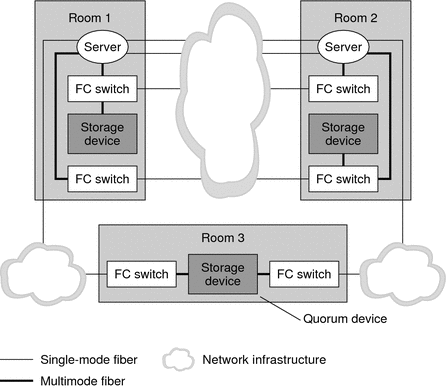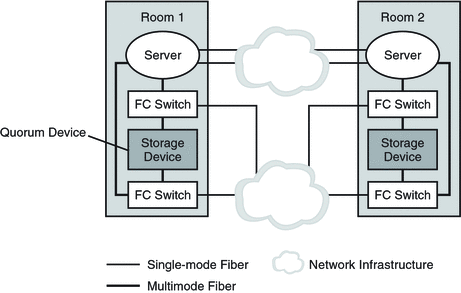Additional Campus Cluster Configuration Examples
While detailing all of the configurations that are possible in campus clustering is beyond the scope of this document, the following illustrations depict variations on the configurations that were previously shown.
-
Three-room campus cluster with a multipathing solution implemented (Figure 7–5)
-
Two-room campus cluster with a multipathing solution implemented (Figure 7–6)
-
Two-room campus cluster without a multipathing solution implemented (Figure 7–7)
Figure 7–5 Three-Room Campus Cluster With a Multipathing Solution Implemented

Figure 7–6 shows a two-room campus cluster that uses partner pairs of storage devices and four FC switches, with a multipathing solution implemented. The four switches are added to the cluster for greater redundancy and potentially better I/O throughput. Other possible configurations that you could implement include using Sun StorEdge T3 partner groups or Sun StorEdge 9910/9960 arrays with Sun StorEdge Traffic Manager or Sun StorEdge Traffic Manager software installed.
For information about Traffic Manager software for the Solaris 9 OS, see the Sun StorEdge Traffic Manager Installation and Configuration Guide at http://dlc.sun.com/pdf/817-3674-12/817-3674-12.pdf. For information about Solaris I/O multipathing software for the Solaris 10 OS, see the Solaris Fibre Channel Storage Configuration and Multipathing Support Guide.
Figure 7–6 Two-Room Campus Cluster With a Multipathing Solution Implemented

The configuration in the following figure could be implemented by using Sun StorEdge T3 or T3+ arrays in single-controller configurations, rather than partner groups.
Figure 7–7 Two-Room Campus Cluster Without a Multipathing Solution Implemented

- © 2010, Oracle Corporation and/or its affiliates
